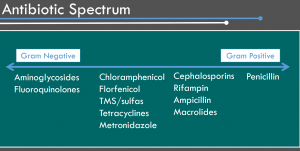General pharmacology
Antibiotics
Ideally, we choose antibiotics based on the specific control need – the type of organism, the level of importance (static vs cidal drugs), and known resistance patterns. Often, we have to include route of administration so that clients (and veterinarians) don’t get hurt when administering longer term therapy. We also have to remember that many oral drugs will not make it past the rumen or C3 to be absorbed by the ruminant patient.
Also ideally, we have a set of guidelines that helps us decide when to pull out the “big guns” (potent antibiotics) and the “big guns” still work because we don’t use them unless necessary. The drugs we can use vary by species and we try to avoid using the “big guns” for prophylactic (preoperative, just in case) administration.
Antibiotics are either bactericidal or bacteriostatic. Bactericidal drugs kill bacteria directly. Bacteriostatic drugs inhibit growth or repilication of bacteria. Bactericidal drugs are used when the level of danger is higher and rapid bacterial control is needed.
| Bactericidal drugs | Bacteriostatic drugs |
|---|---|
| Aminoglycosides
Cephalosporins Fluoroquinolones Metronidazole Penicillins Trimethoprim/sulfonamides |
Chloramphical
Florfenicol Macrolides Sulfonamides Tetracyclines
|
Drugs may damage/kill bacteria using a time-dependent or concentration-dependent mechanism. Concentration dependent drugs need to reach a high drug concentration above the MIC to be fully effective. Concentration dependent drugs that have a long half life work best. Time-dependent drugs need longer periods of drug concentration above their MIC to be fully effective. Very high doses (much higher than the MIC) do not help.
| Concentration-dependent | Time-dependent |
|---|---|
| Aminoglycosides
Fluoroquinolones Metronidazole |
Cephalosporins
Chlorampenicol Florfenicol Macrolides Penicillins Sulfonamides Tetracyclines |
Antimicrobial overview
by Dr. Alex Bianco

| Drug | IV* | IM/SQ* | PO* | Typically best for | Anaerobes | Good penetration |
|---|---|---|---|---|---|---|
| Penicillin | x | x | Gram + | x | ||
| Ampicillin | x | x | Gram + | |||
| Cephalosporins | EQ/SRC | x | Both +/- | |||
| Aminoglycosides | x | x | Gram – | |||
| Fluoroquinolones | EQ | FA | EQ | Gram – | ||
| Macrolides | FA | FA/foals | Gram + | |||
| TMS/sulfas | x | Both +/- | ||||
| Chloramphenical/Florfenicol | FA | EQ | Both +/- | x | x | |
| Rifampin | EQ | NA | x | |||
| Tetracyclines | x | FA | Both +/- | |||
| Metronidazole | foals ($) | EQ | NA | xx |
Drug table listing routes, relative costs, species, typical spectrum, and tissue penetration
*US formulations
Prophylactic drug choices tend to be more consistent as prophylactic use is designed to prevent contamination rather than treat an infection. Bactericidal drugs are preferred. Managing skin flora is a common concern so drugs that tackle gram positive organisms are typically included. If the surgery will involve the GI tract, drugs that will control gram negative organisms are added. Anaerobic organism management is needed when the foot, colon or rumen is involved.
Horses tend to get Excede (a long acting ceftiofur) for castrations and similar superficial procedures. For more involved procedures, they are given gentamicin (for gram negatives) plus penicillin or a cephalosporin (for gram positives). Penicillins are also useful for anaerobic organism management. Trimethoprim sulfa is a combination of bacteriostatic agents that become bactericidal when together. Trimethoprim sulfa can be used as a prophylactic antibiotic but it does need to be administered a few hours prior to surgery since it is an oral drug. It is more commonly used for therapy since it can be given orally and is relatively broad spectrum.
Warning!
Gentamicin is strongly discouraged in food animal species due to the prolonged duration in the kidneys (meat withholding). Gentamicin can stay in the kidneys for 18 months.
Gentamicin is also nephrotoxic. Be careful using it in animals already prone to kidney damage!
Small ruminants and camelids will often get a cephalosporin (more broad spectrum) or ampicillin. Pigs will often also get these drugs as they are approved in swine and can be given intramuscularly.
Beef cattle are treated like small ruminants and camelids and get a penicillin, ampicillin or cephalosporin. For dairy cattle, we often start with ceftiofur sodium even though it is more expensive because it doesn’t add much antibiotic to the milk and the milk can be safely fed to others. Penicillins and similar drugs are leaked into the milk meaning the milk cannot be sold for human consumption. Animals given penicillin have to have their milk kept from market for about 5 days. This can be a big loss compared to animals given ceftiofur.
See the species specific guidelines and timing recommendations
Resources
Antibiotics – A UGA reference for veterinary students, 2018
The amount of time needed for the drug to leave the tissues so that they are safe for human consumption. The standard tissues are meat and milk. FARAD.org is the main source of information for how much time is needed.

